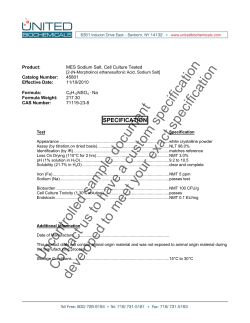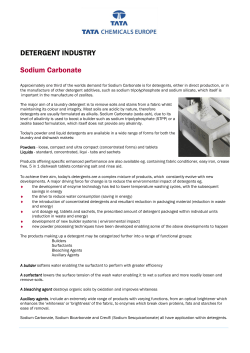
THE CHLOR-ALKALI INDUSTRY Option C12
Option C12 THE CHLOR-ALKALI INDUSTRY C.12.1 DISCUSS THE PRODUCTION OF CHLORINE BY THE ELECTROLYSIS OF SODIUM CHLORIDE. The chlor-alkali industry refers to the production of chlorine, sodium hydroxide and sodium carbonate. Cl2 and NaOH are made from the electrolysis of brine solution (salt water). The commercial methods used include mercury, and diaphragm and membrane cells. C.12.1 DISCUSS THE PRODUCTION OF CHLORINE BY THE ELECTROLYSIS OF SODIUM CHLORIDE. Mercury Cell Process Brine is passed into a cell with positive graphite electrodes. At these anodes, oxidation of chloride ions takes place over hydroxide ions because of the higher concentration of chloride ions. A moving layer of mercury acts as the negative electrode (cathode). Mercury is used because instead of hydrogen being reduced, sodium reacts with mercury forming an amalgam. (Na/Hg) Na+(aq) + e- + Hg(l) → Na/Hg(l) The amalgam then travels…… C.12.1 DISCUSS THE PRODUCTION OF CHLORINE BY THE ELECTROLYSIS OF SODIUM CHLORIDE. The amalgam travels to a chamber containing water. Here, NaOH and H2 are produced. 2Na/Hg + H2O → 2NaOH + 2Hg + H2 The mercury is then recycled to be used again C.12.1 DISCUSS THE PRODUCTION OF CHLORINE BY THE ELECTROLYSIS OF SODIUM CHLORIDE. The negative and positive electrodes are separated by a diaphragm. Diaphragms use asbestos (can cause damage to lungs). Membrane cells use ion-selective membrane technology (allows sodium ions to pass through). Diaphragm allows sodium chloride to pass through, but prevents hydroxide ions from reaching the anode. Positive anode is made from titanium. Negative cathode is made from steel. C.12.1 DISCUSS THE PRODUCTION OF CHLORINE BY THE ELECTROLYSIS OF SODIUM CHLORIDE. What is the half reaction at the anode? 2Cl- → Cl2 + 2e What is the reaction happening at the cathode? 2H2O + 2e- → 2OH- + H2 The hydroxide then combines with sodium to produce sodium hydroxide. Bleach can be produced in a cold environment by reacting chlorine with hydroxide ions: Cl2(aq) + 2OH-(aq) → Cl-(aq) + ClO- + H2O(l) C.12.2 OUTLINE SOME IMPORTANT USES OF THE PRODUCTS OF THIS PROCESS Chlorine: Solvents, manufacturing PVC, Bleaching paper products, Disinfecting drinking and swimming pool water, production of inorganic chemicals. Sodium hydroxide: Manufacture of organic and inorganic chemicals (substitution reactions), Paper (converting wood to pulp), Aluminum industry, making soap. Hydrogen: Hydrogenation, producing HCl, future use in fuel cells? C.12.3 DISCUSS THE ENVIRONMENTAL IMPACT OF THE PROCESSES USED FOR THE ELECTROLYSIS OF SODIUM CHLORIDE Mercury: Supposed to be recycled in the process, but some inevitably escapes into the environment. This mercury reacts with many organic molecules, and intake of these organo-mercury molecules can cause sickness and mercury poisoning. Mercury poisoning can cause damage to the brain and CNS, and cause blindness, kidney failure, diarrhea, and several other problems C.12.3 DISCUSS THE ENVIRONMENTAL IMPACT OF THE PROCESSES USED FOR THE ELECTROLYSIS OF SODIUM CHLORIDE Asbestos: Can cause respiratory tract cancer and asbestosis (respiratory disease caused by inhaling asbestos). Chlorine: Used to make chlorine solvents and CFCs. CFCs form radicals which can deteriorate the ozone layer.
© Copyright 2025





















